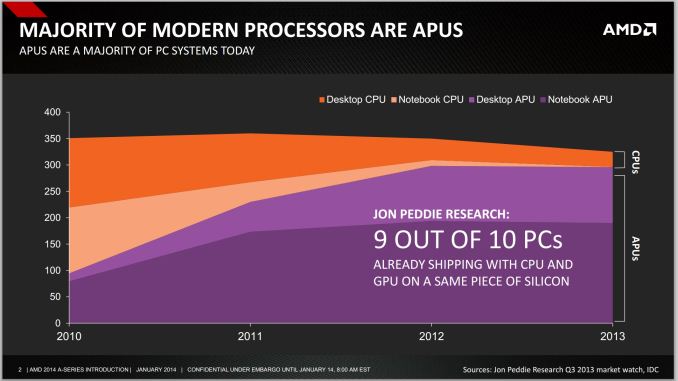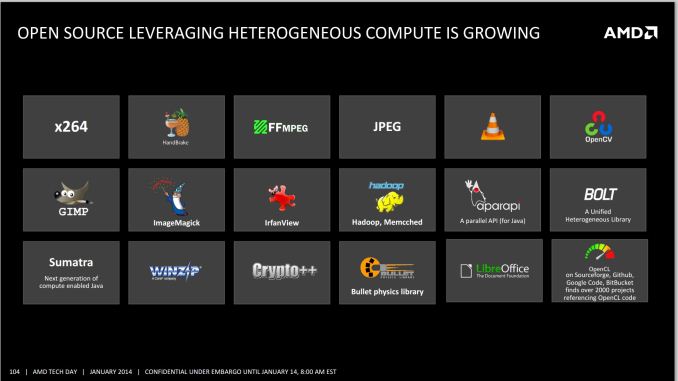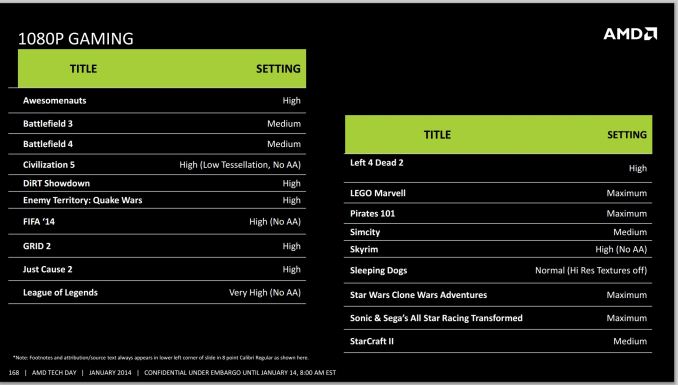AMD Kaveri Review: A8-7600 and A10-7850K Tested
by Ian Cutress & Rahul Garg on January 14, 2014 8:00 AM ESTKaveri: Aiming for 1080p30 and Compute
The numerical differences between Kaveri and Richland are easy enough to rattle off – later in the review we will be discussing these in depth – but at a high level AMD is aiming for a middle ground between the desktop model (CPU + discrete graphics) and Apple’s Mac Pro dream (offloading compute onto different discrete graphics cards) by doing the dream on a single processor. At AMD’s Kaveri tech day the following graph was thrown in front of journalists worldwide:
With Intel now on board, processor graphics is a big deal. You can argue whether or not AMD should continue to use the acronym APU instead of SoC, but the fact remains that it's tough to buy a CPU without an integrated GPU.
In the absence of vertical integration, software optimization always trails hardware availability. If you look at 2011 as the crossover year when APUs/SoCs took over the market, it's not much of a surprise that we haven't seen aggressive moves by software developers to truly leverage GPU compute. Part of the problem has been programming model, which AMD hopes to address with Kaveri and HSA. Kaveri enables a full heterogeneous unified memory architecture (hUMA), such that the integrated graphics topology can access the full breadth of memory that the CPU can, putting a 32GB enabled compute device into the hands of developers.
One of the complexities of compute is also time: getting the CPU and GPU to communicate to each other without HSA and hUMA requires an amount of overhead that is not trivial. For compute, this comes in the form of allowing the CPU and GPU to work on the same data set at the same time, effectively opening up all the compute to the same task without asynchronous calls to memory copies and expensive memory checks for coherency.
The issue AMD has with their HSA ecosystem is the need for developers to jump on board. The analogy oft cited is that on Day 1, iOS had very few apps, yet today has millions. Perhaps a small equivocation fallacy comes in here – Apple is able to manage their OS and system in its entirety, whereas AMD has to compete in the same space as non-HSA enabled products and lacks the control. Nevertheless, AMD is attempting to integrate programming tools for HSA (and OpenCL 2.0) as seamlessly as possible to all modern platforms via a HSA Instruction Layer (HSAIL). The goal is for programming languages like Java, C++ and C++ AMP, as well as common acceleration API libraries and toolkits to provide these features at little or no coding cost. This is something our resident compute guru Rahul will be looking at in further detail later on in the review.
On the gaming side, 30 FPS has been a goal for AMD’s integrated graphics solutions for a couple of generations now.
Arguably we could say that any game should be able to do 30 FPS if we turn down the settings far enough, but AMD has put at least one restriction on that: resolution. 1080p is a lofty goal to hold at 30 FPS with some of the more challenging titles of today. In our testing in this review, it was clear that users had a choice – start with a high resolution and turn the settings down, or keep the settings on medium-high and adjust the resolution. Games like BF4 and Crysis 3 are going to tax any graphics card, especially when additional DirectX 11 features come in to play (ambient occlusion, depth of field, global illumination, and bilateral filtering are some that AMD mention).













380 Comments
View All Comments
fteoath64 - Sunday, January 19, 2014 - link
"Now we need a new one, a fully HSA compliant HyperTransport." Yes! The dedicated people working on new SuperComputers are doing exotic Interconnects close or exceeding 1TBytes/sec speeds but limited by distance naturally. I see that for HyperTransport 3.0 one can implement 10 channels for high aggregated bandwidth, but that will use more transistors. In a budget conscious die size, using eSRAM seems to be a good trick to boost the bandwidth without overt complexity or transistor budget. The downside is eSRAM suck constant power so it becomes a fixture in the TDP numbers. Iris PRO uses 128MB of eDRAM while Xbox One uses 32MB eSRAM. I think the least amount would be somewhere around 24MB for the x86 to be effective in getting effective RAM bandwidth high enough!.The cascading effect if that the memory controller becomes complex and eats into the transistor budget considerably. Seems like a series of moving compromises to get the required performance numbers vs power budget for TDP.
I am actually very excited to see an Arm chip implementing HSA!!.
Samus - Wednesday, January 15, 2014 - link
I don't get why AMD can't compete with Intel's compute performance like they were absolutely able to do a decade ago. Have they lost all their engineering talent? This isn't just a matter of the Intel manufacturing/fab advantage.zodiacfml - Wednesday, January 15, 2014 - link
oh no, after all that, I just came impressed with the Iris Pro. I believe memory bandwidth is needed for Kaveri to stretch its legs.duploxxx - Wednesday, January 15, 2014 - link
impressed with iris pro? for that price difference i would buy a mediocore CPU and dedicated GPU and run circles around it with any game....oaf_king - Wednesday, January 15, 2014 - link
I can point out some carpola here: "I am not sure if this is an effect of the platform or the motherboard, but it will be something to inspect in our motherboard reviews going forward." This sure discounts the major performance benefits you can achieve without faulty hardware. Search the real benchmarks on WCCF tech for A-10 7850 and be amazed. I can STRONGLY DOUBT the CPU has any issue running at 4ghz on a stock cooler/900mhz GPU. Yes the GPU overclock seems skipped over in this Anand review also, but should really pull it into the "useful" category for gaming!oaf_king - Wednesday, January 15, 2014 - link
recall AMD had some leaks suggesting 4ghz CPU / 900Mhz GPU. Is that possible after all? Apparently not all motherboards are faulty. If the TDP tops out at 148 at 4ghz, given the conservative power envelopes already placed on the chip, I'm sure it gets very good performance for between zero and ten extra dollars, and a couple seconds in the BIOS.Fox McCloud - Wednesday, January 15, 2014 - link
Maybe I was skim reading and missed it, but what are the idle power consumption figures for the A8-7600? I need a new home server and I have a iTX system, and mother boards with 6x SATA are slim. It seems the manufacturers only put them on AMD ITX boards, as Intel seem to max out at like 4. I wonder what power figures would be like if under clocked also. I might re-read the review!Excellent review as always guys. So in-depth, informative, technical and unbiased. This is why I love this site and trust your expert opinion :)
Zingam - Wednesday, January 15, 2014 - link
AMDs PR: "The processor that your grandparents dream of!" FYEAHA!keveazy - Wednesday, January 15, 2014 - link
My i5 4440 costs the same as the a10-7850k. I don't think amd will ever compete. By the time they release something that would declare a significant jump, Intel would already have something new to destroy it by then.duploxxx - Wednesday, January 15, 2014 - link
compete to do what? general tasks in a day, just buy an SSD... cost? did check your motherboard price? GPU, did you check the 4600 performance vs a10? it runs circles around it unless you want to be stuck on low resolution with your gorgeous fast cpu.you see customers fool themselve not knowing what to buy for what. hey i have the best benchmarking cpu, but on daily tasks i can't even count the microseconds difference.